Evaluating the Snow Cover Service Value on the Qinghai–Tibet Plateau
Abstract
:1. Introduction
2. Study Area
3. Data and Methods
3.1. Data Sources
3.2. Evaluation System of Snow Cover Service Value
3.3. Assessment Methods Snow Cover Service Value
4. Results
4.1. Temporal Variation of the Snow Cover Service Value
4.2. Spatial Variation of the Snow Cover Service Value
4.3. Monthly Variation in Snow Cover Service Value
4.4. Comparison of Different Ecosystem Services Value
4.5. Influencing Factors of Snow Cover Service Value
5. Discussion
5.1. Recommendations for Protection and Development
5.2. Limitations and Outlook
6. Conclusions
Author Contributions
Funding
Data Availability Statement
Acknowledgments
Conflicts of Interest
Appendix A
| Name | Definition and Function |
|---|---|
| SCSV (Snow Cover Service Value) | This refers to the benefits that humans derive directly or indirectly from snow cover. In the article, SCSV is used to assess the overall economic value of snow cover on the Qinghai–Tibet Plateau, including aspects such as climate regulation and water supply. |
| RRV (Runoff Regulation Value) | This represents the value of snow cover in regulating runoff. In the article, RRV is estimated using the shadow price method, calculating how snow cover supports water resource management by regulating surface water flows. |
| FSV (Freshwater Supply Value) | This reflects the economic contribution of snow cover through providing meltwater resources to human water systems. In the article, FSV is calculated using the market value method. |
| CRV (Climate Regulation Value) | This involves the economic impact of snow cover in regulating the regional climate by reflecting solar radiation. The article assesses CRV using the equivalent factor method, highlighting the importance of snow cover in climate regulation. |
| TRV (Tourism and Recreation Value) | This reflects the economic value of snow cover as a tourism and recreation resource. In the article, TRV is estimated using the travel cost method, indicating the contribution of snowscapes and related activities to the tourism industry. |
| SRV (Scientific Research Value) | This denotes the economic value provided by snow cover for scientific research. In the article, SRV is estimated by linking snow cover to research funding, emphasizing the importance of snow cover research to the scientific community. |
| Shadow price method | Used to evaluate the economic value of environmental resources or public goods, typically employed when market prices are unavailable. This method is used in the article to estimate RRV [52]. |
| Market value method | Directly uses market prices to assess the value of goods or services. In the article, this method is used to calculate FSV, evaluating the supply value of snow water through market water prices [52]. |
| Travel cost method | Used to assess the value of natural or leisure resources based on the travel costs required to access these resources. This method is used in the article to estimate TRV [27]. |
| Equivalent factor method | Converts non-market values (such as environmental services) into economic values, often relying on utility or efficiency factors. This method is used in the article to calculate CRV, showing the cooling costs saved by changing the surface albedo [28,29,30,31,32,33,34,35,36,37,38,39,40,41,42,43,44,45,46,47,48,49,50,51,52,53,54]. |
| Engel’s coefficient | Measures the proportion of household expenditure on food to total expenditure, commonly used to assess economic development levels and living standards. In the article, this coefficient is used to measure tourists’ willingness to pay for snow tourism [27]. |
| Peel’s growth curve | A model that describes the stages of technological or economic development. In the article, this model is used to predict growth trends in snow tourism [27]. |
References
- Sharma, R.C.; Tateishi, R.; Hara, K. A new water-resistant snow index for the detection and mapping of snow cover on a global scale. Int. J. Remote Sens. 2016, 37, 2706–2723. [Google Scholar] [CrossRef]
- Barnett, T.P.; Adam, J.C.; Lettenmaier, D.P. Potential impacts of a warming climate on water availability in snow-dominated regions. Nature 2005, 438, 303–309. [Google Scholar] [CrossRef] [PubMed]
- Qin, Y.; Hong, C.P.; Zhao, H.Y.; Siebert, S.; Abatzoglou, J.T.; Huning, L.S.; Sloat, L.L.; Park, S.; Li, S.Y.; Munroe, D.K.; et al. Snowmelt risk telecouplings for irrigated agriculture. Nat. Clim. Change 2022, 12, 1007–1015. [Google Scholar] [CrossRef]
- Bormann, K.J.; Brown, R.D.; Derksen, C.; Painter, T.H. Estimating snow-cover trends from space. Nat. Clim. Change 2018, 8, 923–927. [Google Scholar] [CrossRef]
- Mote, T.L. On the role of snow cover in depressing air temperature. J. Appl. Meteorol. Climatol. 2008, 47, 2008–2022. [Google Scholar] [CrossRef]
- Qu, X.; Hall, A. What controls the strength of snow-albedo feedback? J. Clim. 2007, 20, 3971–3981. [Google Scholar] [CrossRef]
- Abe, M. Impact of snow-albedo feedback termination on terrestrial surface climate at midhigh latitudes: Sensitivity experiments with an atmospheric general circulation model. Int. J. Climatol. 2022, 42, 3838–3860. [Google Scholar] [CrossRef]
- Xiao, C.; Wang, S.; Qin, D. A preliminary study of cryosphere service function and value evaluation. Adv. Clim. Change Res. 2015, 6, 181–187. [Google Scholar] [CrossRef]
- Lutz, J. Skiing from Top to Bottom: The History of Skiing in Canaan Valley. Southeast. Nat. 2015, 14, 447–454. [Google Scholar] [CrossRef]
- Liu, S.; Guo, Q. Image perception of ice and snow tourism in China and the impact of the Winter Olympics. PLoS ONE 2023, 18, e0287530. [Google Scholar] [CrossRef]
- Ding, Y.J.; Mu, C.C.; Wu, T.H.; Hu, G.J.; Zou, D.F.; Wang, D.; Li, W.P.; Wu, X.D. Increasing cryospheric hazards in a warming climate. Earth-Sci. Rev. 2021, 213, 103500. [Google Scholar] [CrossRef]
- Kunkel, K.E.; Robinson, D.A.; Champion, S.; Yin, X.G.; Estilow, T.; Frankson, R.M. Trends and Extremes in Northern Hemisphere Snow Characteristics. Curr. Clim. Change Rep. 2016, 2, 65–73. [Google Scholar] [CrossRef]
- Brown, R.D. Northern hemisphere snow cover variability and change, 1915–97. J. Clim. 2000, 13, 2339–2355. [Google Scholar] [CrossRef]
- Wang, Z.B.; Wu, R.G.; Huang, G. Low-frequency snow changes over the Tibetan Plateau. Int. J. Climatol. 2018, 38, 949–963. [Google Scholar] [CrossRef]
- Euskirchen, E.S.; McGuire, A.D.; Chapin, F.S. Energy feedbacks of northern high-latitude ecosystems to the climate system due to reduced snow cover during 20th century warming. Glob. Change Biol. 2007, 13, 2425–2438. [Google Scholar] [CrossRef]
- Chen, X.; Wei, W.S.; Liu, M.Z. Characteristics of temperature variation in seasonal snow in the Western Tianshan Mountains, China. Meteorol. Appl. 2013, 20, 457–465. [Google Scholar] [CrossRef]
- Yao, T.; Qin, D.; Shen, Y.; Zhao, L.; Wang, N.; Lu, A. Cryospheric changes and their impacts on regional water cycle and ecological conditions in the Qinghai Tibetan Plateau. Chin. J. Nat. 2013, 35, 179–186. [Google Scholar]
- O’Gorman, P.A. Contrasting responses of mean and extreme snowfall to climate change. Nature 2014, 512, 416–418. [Google Scholar] [CrossRef]
- Wang, S.; Xu, X.; Dou, W.; Qin, D. Special regionalization of cryosphere culture service in China. Acta Geogr. Sin. 2022, 77, 16–34. [Google Scholar]
- Wang, S.; Ding, Y.; Xiao, C. Integrated impacts of cryosphere change on the economic and social system and its adaptive management strategies. J. Glaciol. Geocryol. 2018, 40, 863–874. [Google Scholar]
- Costanza, R.; dArge, R.; deGroot, R.; Farber, S.; Grasso, M.; Hannon, B.; Limburg, K.; Naeem, S.; Oneill, R.V.; Paruelo, J.; et al. The value of the world’s ecosystem services and natural capital. Nature 1997, 387, 253–260. [Google Scholar] [CrossRef]
- Xiao, H.; Hu, C.; Chi, Y.K. Preliminary Evaluation Of Ecosystem Service Value Of Natural Grassland In China. Fresenius Environ. Bull. 2021, 30, 2670–2685. [Google Scholar]
- Liu, H.; Wang, R.Z.; Sun, H.Y.; Cao, W.J.; Song, J.; Zhang, X.F.; Wen, L.; Zhuo, Y.; Wang, L.X.; Liu, T.J. Spatiotemporal evolution and driving forces of ecosystem service value and ecological risk in the Ulan Buh Desert. Front. Environ. Sci. 2023, 10, 1053797. [Google Scholar] [CrossRef]
- Fujii, H.; Sato, M.; Managi, S. Decomposition Analysis of Forest Ecosystem Services Values. Sustainability 2017, 9, 687. [Google Scholar] [CrossRef]
- Barbier, E.B.; Hacker, S.D.; Kennedy, C.; Koch, E.W.; Stier, A.C.; Silliman, B.R. The value of estuarine and coastal ecosystem services. Ecol. Monogr. 2011, 81, 169–193. [Google Scholar] [CrossRef]
- Zhang, Z.Y.; Liu, L.; He, X.L.; Li, Z.Q.; Wang, P.Y. Evaluation on glaciers ecological services value in the Tianshan Mountains, Northwest China. J. Geogr. Sci. 2019, 29, 101–114. [Google Scholar] [CrossRef]
- Sun, M.P.; Ma, W.Q.; Yao, X.J.; Zhang, Y.; Yang, Y. Evaluation of glacier service function and value in the Sanjiangyuan Nature Reserve in China (SNRC). J. Clean. Prod. 2023, 412, 137284. [Google Scholar] [CrossRef]
- Yang, Y.; Wu, X.J.; Liu, S.W.; Xiao, C.D.; Wang, X.M. Valuating service loss of snow cover in Irtysh River Basin. Adv. Clim. Change Res. 2019, 10, 109–114. [Google Scholar] [CrossRef]
- Liu, S.; Wang, X.; Xiao, C.; Yang, Y.; Wu, X. Evaluating climate regulation service of snow cover in China. Progress. Inquisitiones Mutat. Clim. 2020, 16, 536–544. [Google Scholar]
- Chen, X.Q.; An, S.; Inouye, D.W.; Schwartz, M.D. Temperature and snowfall trigger alpine vegetation green-up on the world’s roof. Glob. Change Biol. 2015, 21, 3635–3646. [Google Scholar] [CrossRef]
- Liang, L.Q.; Li, L.J.; Liu, C.M.; Cuo, L. Climate change in the Tibetan Plateau Three Rivers Source Region: 1960–2009. Int. J. Climatol. 2013, 33, 2900–2916. [Google Scholar] [CrossRef]
- Zhu, J.; Shi, J.C.; Wang, Y.H. Subpixel snow mapping of the Qinghai-Tibet Plateau using MODIS data. Int. J. Appl. Earth Obs. Geoinf. 2012, 18, 251–262. [Google Scholar] [CrossRef]
- Jiang, W.; Jiala; Xiao, T.; Luobu, J.; Zhou, Z. Climate change and spatial distribution of winter snowfall over the Tibetan Plateau during 1971–2010. J. Glaciol. Geocryol. 2016, 38, 1211–1218. [Google Scholar]
- Chu, D.; Luosang, Q.; Yang, Z.; Yang, Y. Spatiotemporal Variations of Snowfall Days over the Tibetan Plateau from 1981 to 2010. J. Appl. Meteorolgical Sci. 2017, 28, 292–305. [Google Scholar]
- Zhu, X.; Zhang, M.; Wang, S.; Li, X.; Dong, L.; Ren, Z. Spatiotemporal variation patterns of the beginning and ending dates of snowfall, and snowfall days in Qinghai Province during 1962 to 2012. Chin. J. Ecol. 2014, 33, 761–770. [Google Scholar]
- Wang, W.; Huang, X.D.; Deng, J.; Xie, H.J.; Liang, T.G. Spatio-Temporal Change of Snow Cover and Its Response to Climate over the Tibetan Plateau Based on an Improved Daily Cloud-Free Snow Cover Product. Remote Sens. 2015, 7, 169–194. [Google Scholar] [CrossRef]
- Wang, J.; Che, T.; Li, Z.; Li, H.; Hao, X.; Zheng, Z.; Xiao, P.; Li, X.; Huang, X.; Zhong, X.; et al. Investigation on Snow Characteristics and Their Distribution in China. Adv. Earth Sci. 2018, 33, 12–26. [Google Scholar]
- Jiang, L.; Yang, J.; Zhang, C.; Wu, S.; Li, Z.; Dai, L.; Li, X.; Qiu, Y. Daily snow water equivalent product with SMMR, SSM/I and SSMIS from 1980 to 2020 over China. Big Earth Data 2022, 6, 420–434. [Google Scholar] [CrossRef]
- Yang, Y.; Chen, R.S.; Liu, G.H.; Liu, Z.W.; Wang, X.Q. Trends and variability in snowmelt in China under climate change. Hydrol. Earth Syst. Sci. 2022, 26, 305–329. [Google Scholar] [CrossRef]
- Zhang, Z.; Xiao, P.; Zhang, X.; Feng, X.; Yang, Y.; Hu, R.; Sheng, G.; Liu, H. Analysis of the Characteristics of Snow Albedo during the Snowmelt Period of the Qinghai-Tibet Plateau. Remote Sens. Technol. Appl. 2019, 34, 1146–1154. [Google Scholar] [CrossRef]
- Ye, L.Z.; Xiao, P.F.; Zhang, X.L.; Feng, X.Z.; Hu, R.; Ma, W.; Li, H.X.; Song, Y.N.; Ma, T.Y. Evaluating Snow Bidirectional Reflectance of Models Using Multiangle Remote Sensing Data and Field Measurements. IEEE Geosci. Remote Sens. Lett. 2022, 19, 2000205. [Google Scholar] [CrossRef]
- Sheng, G.; Xiao, P.; Zhang, X.; Feng, X.; Yang, Y.; Hu, R.; Liu, H.; Zhang, Z. Differences in snow albedo between Tianshan Mountains and northern Xinjiang. Arid Land Geogr. 2019, 42, 774–781. [Google Scholar]
- Liu, H.; Xiao, P.; Zhang, X.; Feng, X.; Yang, Y.; Hu, R.; Zhang, Z.; Sheng, G. The characteristics of snow cover albedo in Northeast China. J. Glaciol. Geocryol. 2019, 41, 554–562. [Google Scholar]
- Wang, Z.S. Satellite-Observed Effects from Ozone Pollution and Climate Change on Growing-Season Vegetation Activity over China during 1982–2020. Atmosphere 2021, 12, 1390. [Google Scholar] [CrossRef]
- Zhao, Q.; Hao, X.; Wang, J.; Sun, X.; Li, H. A dataset of snow cover phenology in China based on MODIS during 2000–2020. China Sci. Data 2022, 7, 6. [Google Scholar]
- Qinghai Provincial Bureau of Statistics. Available online: http://tjj.qinghai.gov.cn/tjData/qhtjnj/ (accessed on 3 July 2024).
- Tibet Autonomous Region Bureau of Statistics. Available online: https://tjj.xizang.gov.cn/xxgk/tjxx/tjgb/ (accessed on 3 July 2024).
- National Bureau of Statistics of China. Available online: https://data.stats.gov.cn/easyquery.htm?cn=C01 (accessed on 3 July 2024).
- National Natural Science Foundation of China (NSFC). Available online: https://www.citexs.com/nsfc (accessed on 3 July 2024).
- Peng, S.Z.; Gang, C.C.; Cao, Y.; Chen, Y.M. Assessment of climate change trends over the Loess Plateau in China from 1901 to 2100. Int. J. Climatol. 2018, 38, 2250–2264. [Google Scholar] [CrossRef]
- Peng, S.Z.; Ding, Y.X.; Wen, Z.M.; Chen, Y.M.; Cao, Y.; Ren, J.Y. Spatiotemporal change and trend analysis of potential evapotranspiration over the Loess Plateau of China during 2011–2100. Agric. For. Meteorol. 2017, 233, 183–194. [Google Scholar] [CrossRef]
- Zhang, Z.; He, X.; Liu, L.; Li, Z.; Wang, P. Ecological service functions and value estimation of glaciers in the Tianshan Mountains, China. Acta Geogr. Sin. 2018, 73, 856–867. [Google Scholar]
- Du, H.; Yu, S.; Zhang, P.; Zhang, L. Assessing payment for ecosystem services based on water retention value flow in Beijing-Tianjin-Hebei region. Acta Ecol. Sin. 2022, 42, 9871–9885. [Google Scholar]
- Sun, M.P.; Ma, W.Q.; Yao, X.J.; Zhao, L.L.; Li, Z.Q.; Qin, D.H. Evaluation and spatiotemporal characteristics of glacier service value in the Qilian Mountains. J. Geogr. Sci. 2020, 30, 1233–1248. [Google Scholar] [CrossRef]
- Shen, L.; Wu, T.; You, Q.; Jiang, G.; Xie, X.; Zhu, L.; Yin, J. Analysis of the characteristics of spatial and temporal variations of snow depth and their causes over the central and eastern Tibetan Plateau. J. Glaciol. Geocryol. 2019, 41, 1150–1161. [Google Scholar]
- Wang, Y.; Guo, S.; Wang, J.; Yuan, H.; Xu, B.; Wang, D. Estimation of Forest Ecosystem Service Value in the Qilian Mountains National Nature Reserve in Gansu of China. J. Desert Res. 2013, 33, 1905–1911. [Google Scholar]
- Chen, C.; Tao, Z.; Wang, H.; Dai, J. Ecosystem Service Assessment of Grasslands in the Sanjiangyuan Region. Prog. Geogr. 2012, 31, 978–984. [Google Scholar]
- Yi-Qun, W. Evaluation of Wetland Ecosystem Service in Keluke Lake–Toson Lake Nature Reserve of Qinghai. Shaanxi For. Sci. Technol. 2017, 4, 39–42. [Google Scholar]
- Xiao-Mei, W.; Yan-Wei, C.; Cai, C.; Yi-Jun, B.U. Impact Assessment of Ecological Service Value in the Rapid Urbanization Areas of Qinghai-Tibet Plateau:A Case Study of Xining. China Popul. Resour. Environ. 2014, 24, 435–439. [Google Scholar]
- Wang, S.J.; Qin, D.H. Mountain inhabitants’ perspectives on climate change, and its impacts and adaptation based on temporal and spatial characteristics analysis: A case study of Mt. Yulong Snow, Southeastern Tibetan Plateau. Environ. Hazards-Hum. Policy Dimens. 2015, 14, 122–136. [Google Scholar]
- Xiao, C.; Wang, S.; Qin, D. A Preliminary Study on Cryosphere Service Function and Its Value Estimation. Progress. Inquisitiones Mutat. Clim. 2016, 12, 45–52. [Google Scholar]

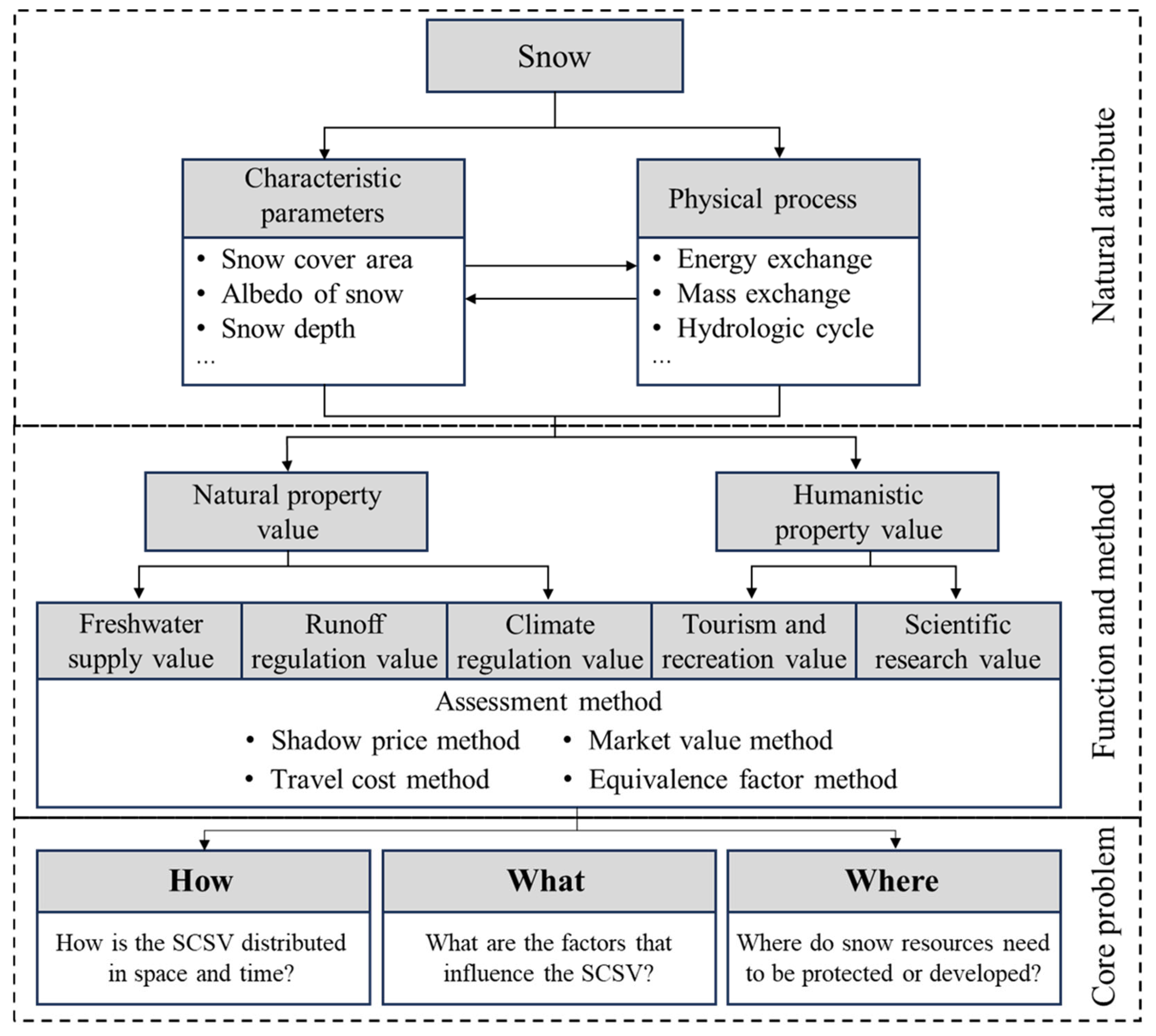
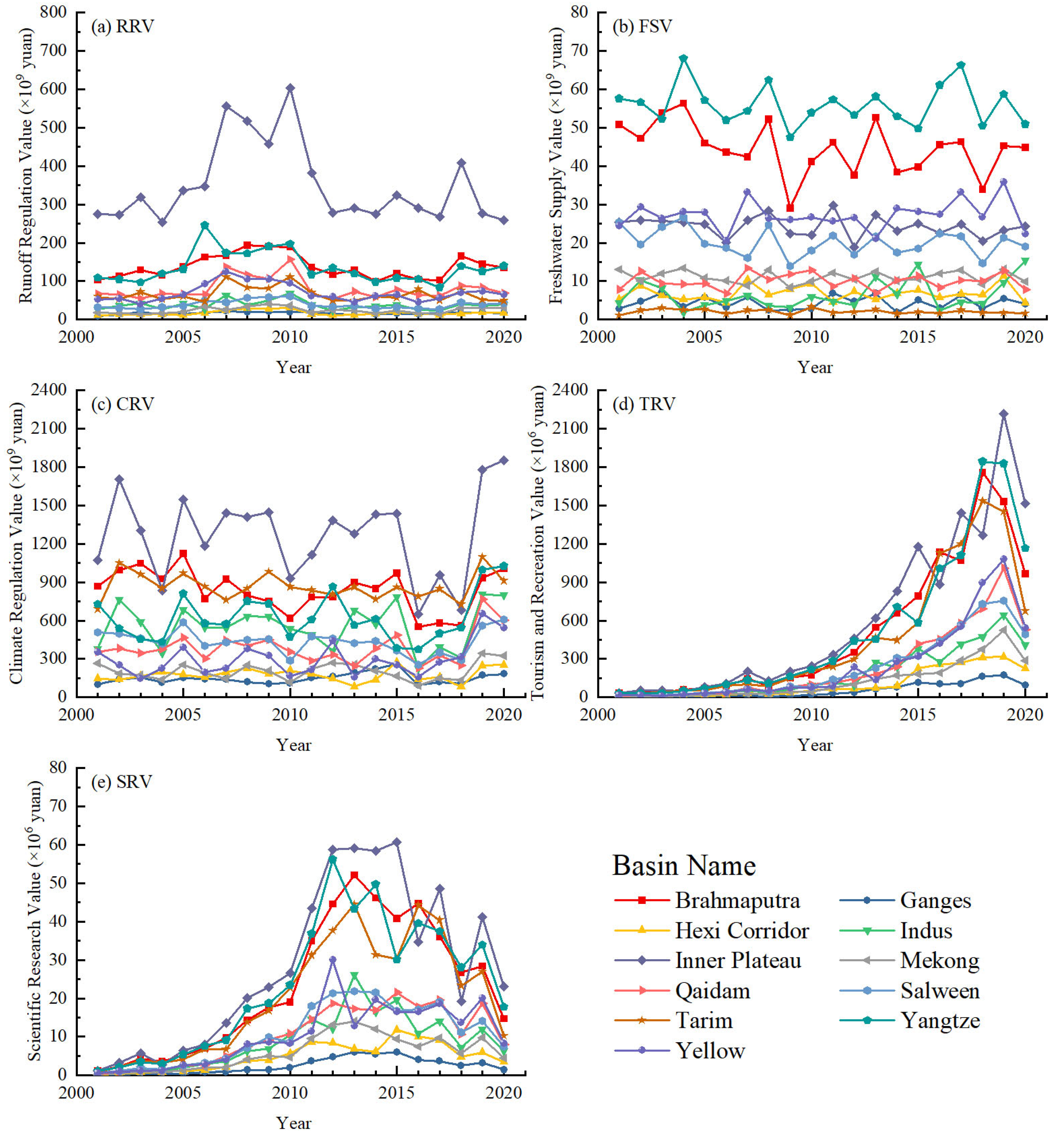
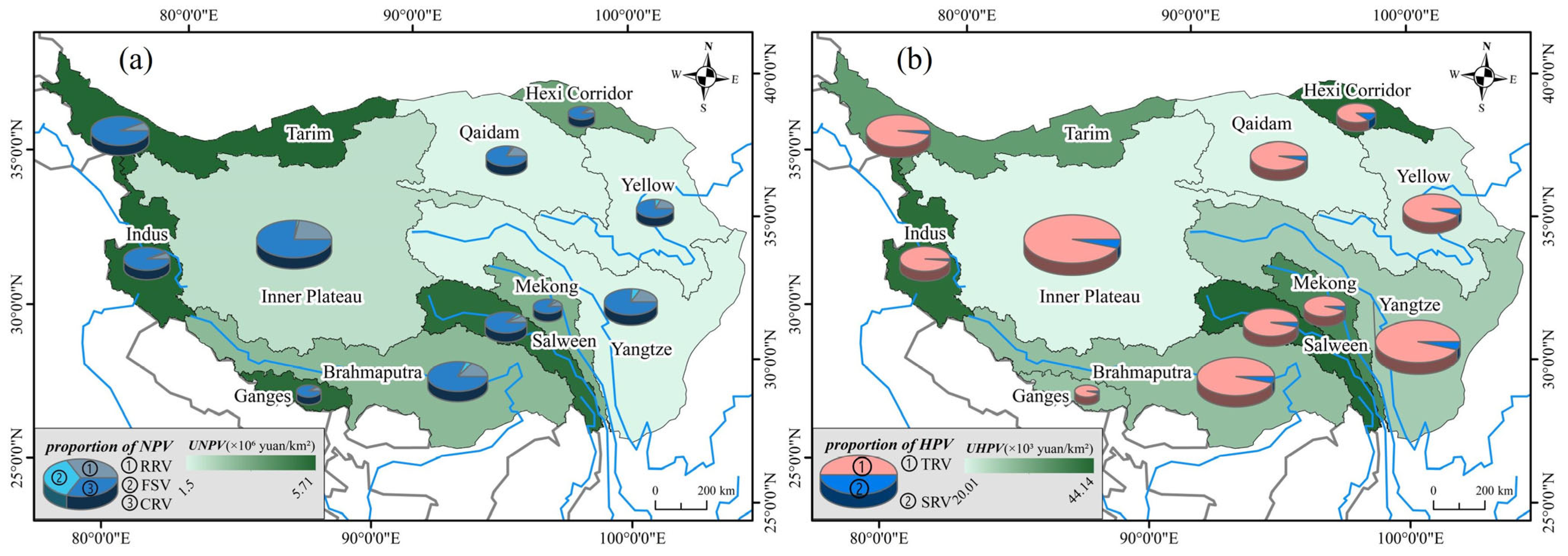
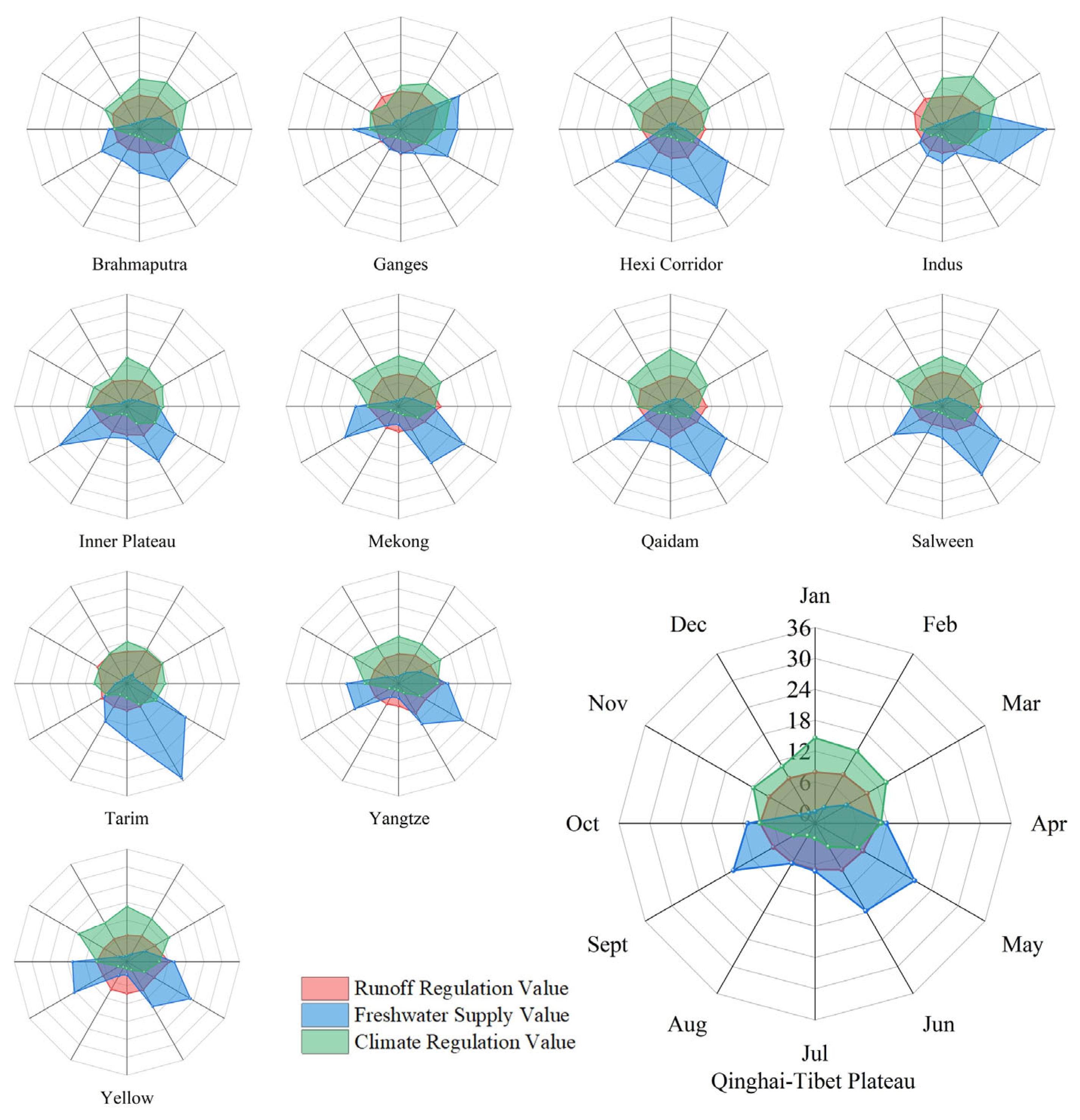
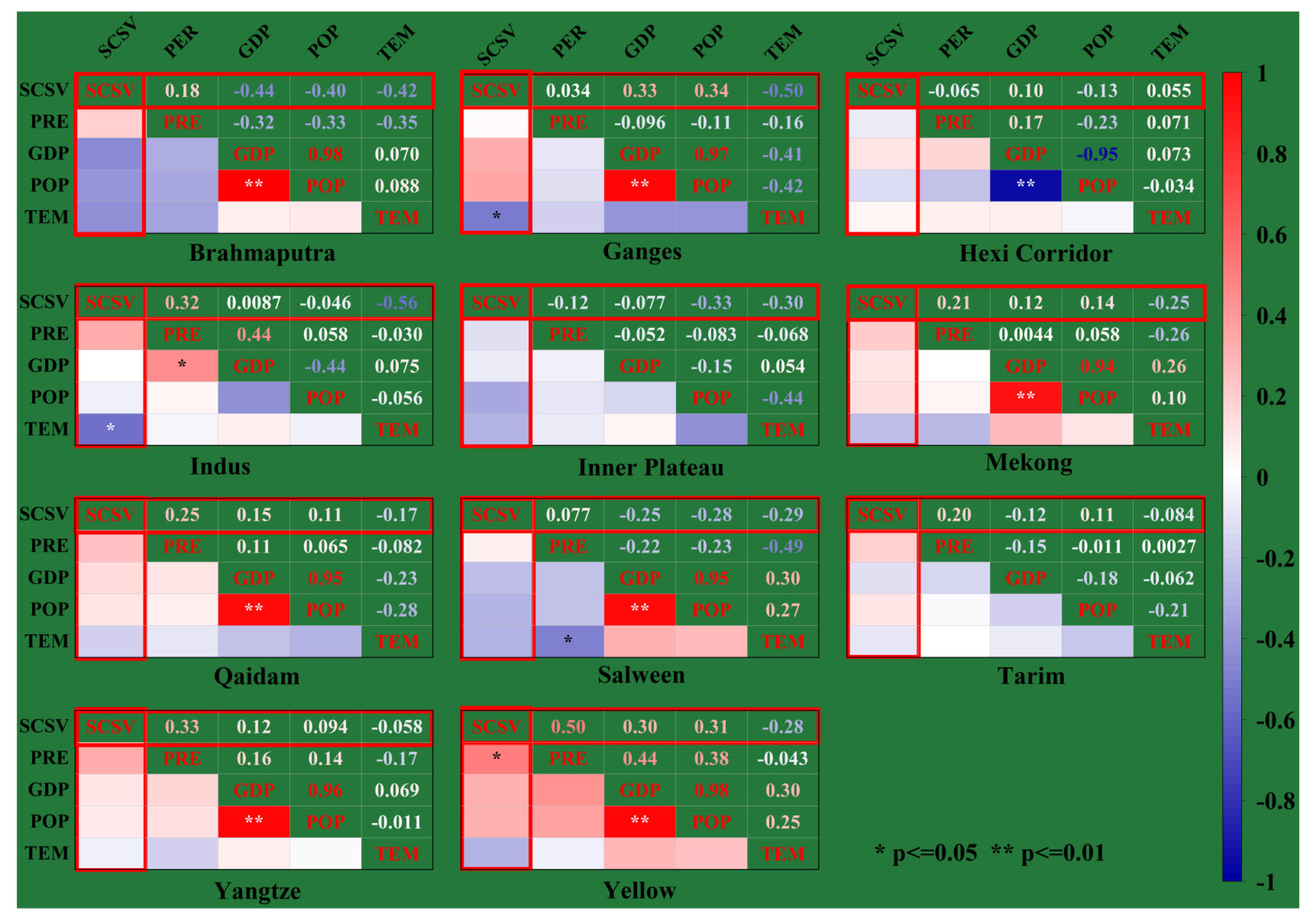
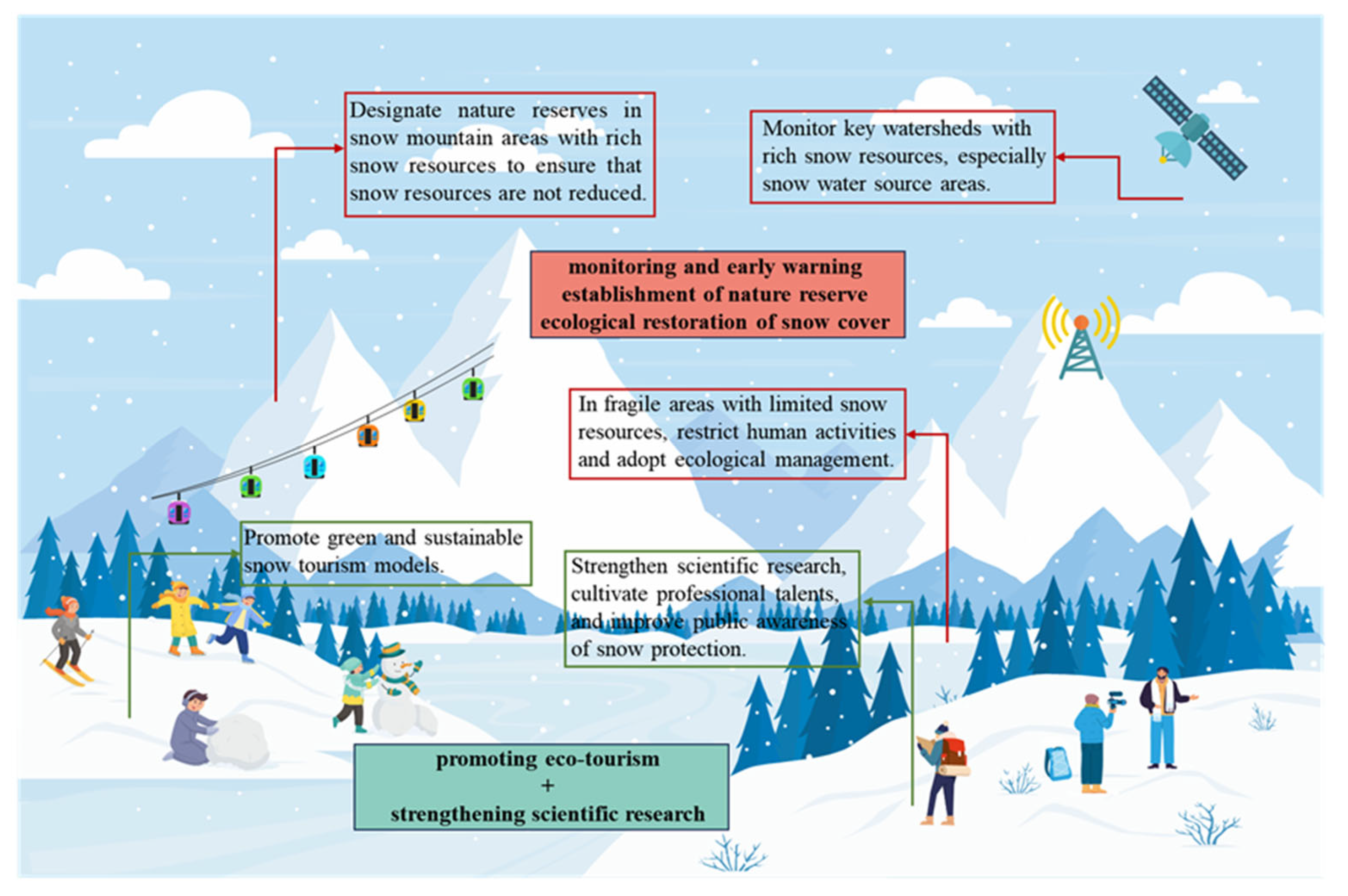
| Name | Type | Resolution | Data Source |
|---|---|---|---|
| Snow water equivalent | Raster | 25 km | Snow water equivalent 25 km daily product in China from 1980 to 2020 [37,38] |
| Snowmelt | Raster | 1 km | Monthly snowmelt dataset in China during 1951–2020 [39] |
| Snow albedo | Raster | 1 km | China cloud-removal snow albedo product data set (2000–2020) [40,41,42,43] |
| Net solar radiation | Raster | 1 km | China’s net solar radiation data set based on era5 from 1982 to 2020 [44] |
| Snow cover days | Raster | 1 km | A dataset of snow phenology in China based on MODIS from 2000 to 2020 [45] |
| Tourism income | Statistical data | 1 year | Qinghai Province National Economic and Social Development Statistical Bulletin (2001–2020) [46] Statistical Bulletin on National Economic and Social Development of Tibet Autonomous Region (2001–2020) [47] |
| Engel coefficient | Statistical data | 1 year | Statistical Bulletin of the People’s Republic of China on National Economic and Social Development (2001–2020) [48] |
| research funding | Statistical data | 1 year | National Natural Science Foundation of China [49] |
| temperature | Raster | 1 km | 1-km monthly mean temperature dataset for China (1901–2022) [50] |
| precipitation | Raster | 1 km | 1-km monthly precipitation dataset for China (1901–2022) [51] |
| Type | Formula | Parameters | Calculation Basis |
|---|---|---|---|
| RRV | Shadow price method [52] | Where is the RRV of the average annual snow cover (yuan), is the daily snow cover area (km2), is the daily snow water equivalent (mm), and is the unit reservoir cost (yuan/m3), which was 8.39 yuan/m3 in 2018 [53]. Calculated according to the fixed asset price index, the unit reservoir cost in 2020 is 8.4 yuan/m3. | Convert snowmelt water into mountain reservoir capacity, then calculate the runoff regulation value by combining it with the unit cost of reservoir storage. |
| FSV | Market value method [52] | Where is the FSV of snow cover in a certain year (yuan), is the snow cover area of a certain month (km2), is the equivalent of snow melting water in a certain month (mm), and is the average water supply price on the QTP, which is 1.87 yuan/m3. | Calculate the total amount of snow water by using the total snow area and snowmelt equivalent, and then determine the freshwater supply value by combining it with the market water price. |
| CRV | Equivalent factor method [54] | Where is the CRV of snow cover (yuan), is the air-conditioning refrigeration efficiency ratio, which is taken as 0.3, and is the average price of electricity on the QTP, which is taken as 0.52 yuan/kw·h; is the contribution rate of solar radiation reflected by snow cover in a year (kw·h), is the land surface albedo caused by snow cover, is the net surface radiation flux caused by albedo changes (W/m2), is the proportion of snow cover accumulation time in a certain place in the year, and is the annual average solar radiation time, which is 3000 h/year. | Calculate the climate regulation value by equating the solar radiation reflected by the snow surface to the equivalent amount of heat reduction during air conditioning cooling. |
| TRV | Travel cost method [27] | Where is the willingness to pay for tourism, is the Engel coefficient, is the TRV of snow cover (yuan), and is the total tourism income (yuan). | Determine the tourism and recreation value by calculating people’s willingness to pay for tourism and combining it with snow tourism income. |
| SRV | Equivalent factor method [28] | Where is the SRV of snow cover (yuan), and is the sum of relevant scientific research funds (yuan). | Estimate the scientific research value based on the total amount of snow-related projects in the QTP funded by the National Natural Science Foundation of China, although this might somewhat overestimate the value. |
| Basin Name | RRV (×109 yuan) | FSV (×109 yuan) | CRV (×109 yuan) | TRV (×106 yuan) | SRV (×106 yuan) | |||||
|---|---|---|---|---|---|---|---|---|---|---|
| Values | Variation | Values | Variation | Values | Variation | Values | Variation | Values | Variation | |
| Brahmaputra | 137.76 | −0.01 | 44.66 | −0.35 | 836.74 | −0.01 | 498.14 | 0.01 | 22.65 | 0.25 |
| Ganges | 16.26 | 0.25 | 4.35 | 0.06 | 146.86 | 0.04 | 51.88 | 0.10 | 2.40 | 1.97 |
| Hexi Corridor | 17.38 | 0.04 | 6.79 | 0.26 | 174.96 | 0.02 | 105.16 | 0.05 | 4.74 | 1.20 |
| Indus | 37.49 | −0.05 | 6.46 | 0.50 | 553.72 | 0.002 | 184.16 | 0.03 | 8.75 | 0.54 |
| Inner Plateau | 349.25 | −0.01 | 24.25 | −0.57 | 1272.56 | 0.001 | 594.41 | 0.01 | 27.86 | 0.19 |
| Mekong | 24.08 | 0.15 | 11.11 | −0.25 | 204.17 | 0.01 | 127.88 | 0.04 | 5.80 | 0.92 |
| Qaidam | 79.85 | −0.01 | 10.03 | 0.05 | 389.34 | 0.01 | 239.81 | 0.02 | 10.28 | 0.65 |
| Salween | 38.52 | 0.004 | 20.11 | −0.55 | 436.20 | −0.01 | 228.55 | 0.02 | 10.44 | 0.56 |
| Tarim | 65.69 | −0.05 | 2.05 | −2.46 | 866.48 | −0.003 | 442.31 | 0.01 | 20.03 | 0.28 |
| Yangtze | 135.47 | −0.02 | 56.02 | −0.12 | 626.78 | 0.01 | 518.04 | 0.01 | 23.18 | 0.25 |
| Yellow | 69.47 | −0.02 | 27.22 | 0.28 | 298.44 | 0.02 | 246.78 | 0.02 | 10.26 | 0.54 |
| Total | 971.22 | −0.002 | 213.04 | −0.05 | 5806.25 | 0.001 | 3237.12 | 0.002 | 146.39 | 0.04 |
| Service Types | The Proportion of Each Ecosystem Service Value (%) | |||||
|---|---|---|---|---|---|---|
| Snow Cover a | Glacier b | Forest c | Grassland d | Wetland e | Urban Area f | |
| Freshwater supply/Product supply | 3.01 | 5.22 | - | 19.85 | 2.46 | 5.97 |
| Runoff regulation/Water conservation | 13.96 | 33.14 | 14.03 | 1.99 | 54.12 | 27.31 |
| Climate regulation | 82.98 | 60.7 | 12.69 | 48.69 | 24.12 | 14.26 |
| Soil conservation | - | - | 46.59 | 9.93 | 0.12 | 11.23 |
| Habitat Support/Biodiversity | - | 0.05 | 26.68 | 19.37 | 18.29 | 34.87 |
| Travel and recreation/Aesthetics | 0.047 | 0.85 | 0.01 | 0.18 | 0.77 | 6.36 |
| Scientific research | 0.003 | 0.04 | - | - | 0.12 | - |
| Target Area | Feature | Suggestions and Measures |
|---|---|---|
| Brahmaputra | SCSV accounts for 14.58% | Long-term monitoring and early warning, pay attention to changes in water source areas. |
| Ganges | Unit SCSV is 1.76 times the average value, and sensitive to temperature | Establish a snow nature reserve and pay attention to temperature changes in snow-covered areas. |
| Hexi Corridor | Unit humanistic property value is 1.44 times the average value | Promote eco-tourism and strengthen scientific research. |
| Indus | Unit SCSV is 2.21 times the average value, snow melt water is concentrated, and the SCSV is sensitive to temperature | Establish a snow nature reserve, pay attention to seasonal snow melt water disasters, and pay attention to temperature changes. |
| Inner Plateau | SCSV is accounts for 23.54% | Long-term monitoring and early warning, and pay attention to changes in snow water source areas. |
| Mekong | Unit SCSV is 1.13 times the average value | Establish a snow nature reserve. |
| Qaidam | Snow melt period is shorter | Prevent drought disaster. |
| Salween | Unit SCSV is 1.7 times the average value | Establish a snow nature reserve. |
| Tarim | Unit SCSV is 1.74 times the average value, snow melt water is concentrated | Establish a snow nature reserve and pay attention to seasonal snow melt water disasters. |
| Yangtze | SCSV accounts for 11.71%, while the unit SCSV is 0.69 times the average value | Long-term monitoring and early warning, manage and restore snow cover resources. |
| Yellow | Unit SCSV is 0.58 times the average value, the SCSV is sensitive to precipitation | Manage and restore snow cover resources, pay special attention to monitoring precipitation changes in snow-covered areas. |
Disclaimer/Publisher’s Note: The statements, opinions and data contained in all publications are solely those of the individual author(s) and contributor(s) and not of MDPI and/or the editor(s). MDPI and/or the editor(s) disclaim responsibility for any injury to people or property resulting from any ideas, methods, instructions or products referred to in the content. |
© 2024 by the authors. Licensee MDPI, Basel, Switzerland. This article is an open access article distributed under the terms and conditions of the Creative Commons Attribution (CC BY) license (https://creativecommons.org/licenses/by/4.0/).
Share and Cite
Gao, X.; Feng, Q.; Liu, W.; Deng, X.; Zhu, M.; Zhang, B.; Xue, J. Evaluating the Snow Cover Service Value on the Qinghai–Tibet Plateau. Remote Sens. 2024, 16, 2600. https://doi.org/10.3390/rs16142600
Gao X, Feng Q, Liu W, Deng X, Zhu M, Zhang B, Xue J. Evaluating the Snow Cover Service Value on the Qinghai–Tibet Plateau. Remote Sensing. 2024; 16(14):2600. https://doi.org/10.3390/rs16142600
Chicago/Turabian StyleGao, Xianglong, Qi Feng, Wen Liu, Xiaohong Deng, Meng Zhu, Baiting Zhang, and Jian Xue. 2024. "Evaluating the Snow Cover Service Value on the Qinghai–Tibet Plateau" Remote Sensing 16, no. 14: 2600. https://doi.org/10.3390/rs16142600






